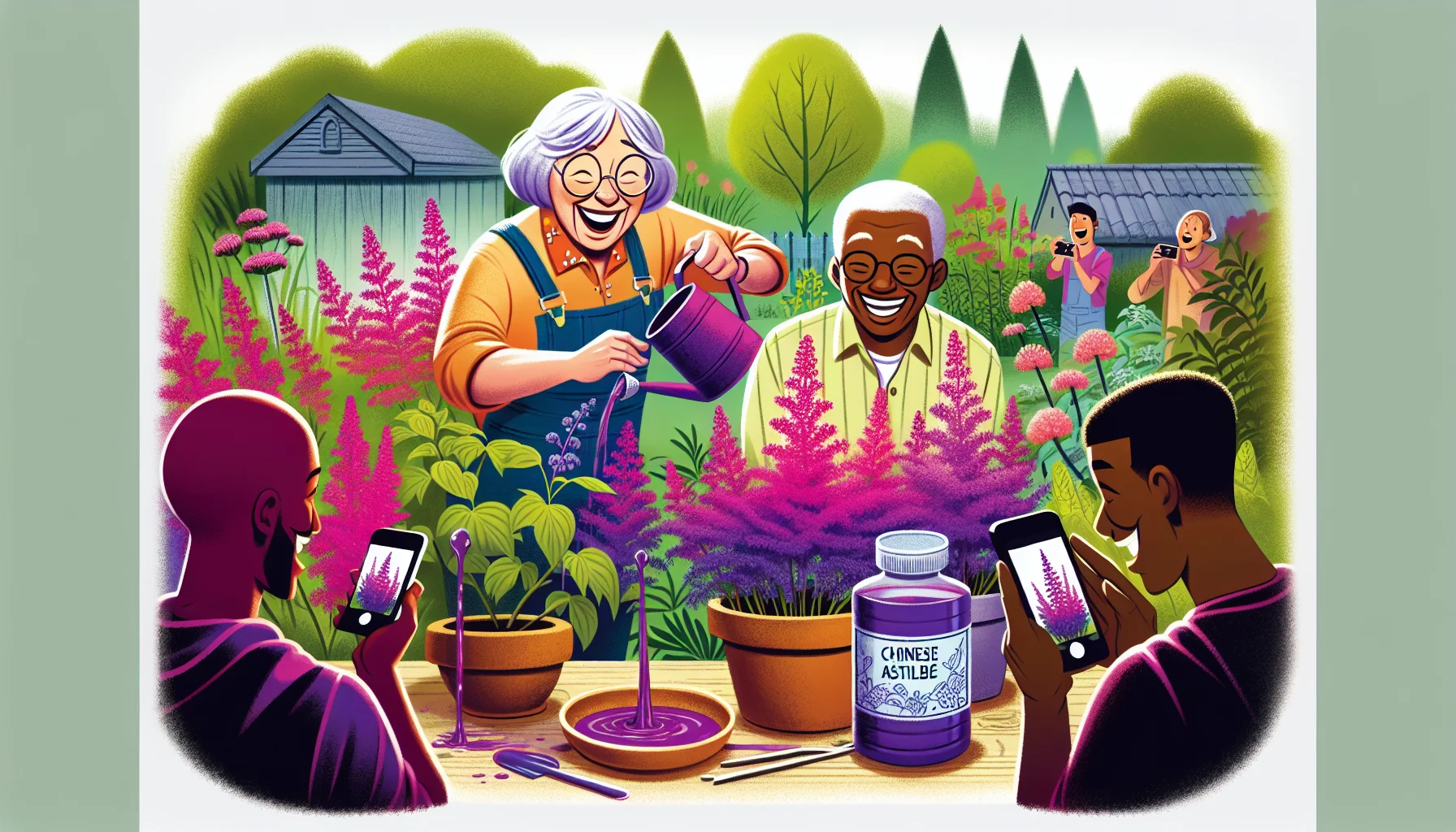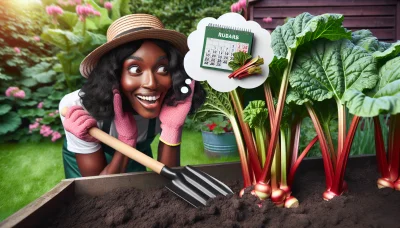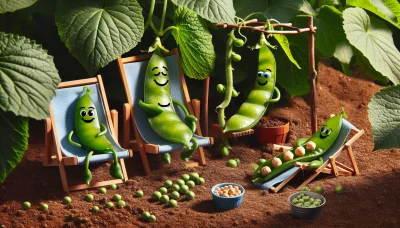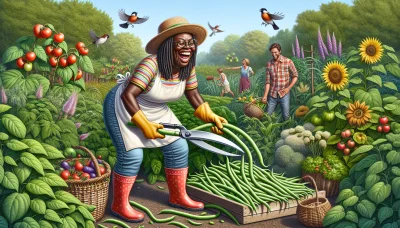Chinese astilbe Quiz
Test Your Knowledge
Question of
Introduction to Chinese Astilbe
Chinese Astilbe, known scientifically as Astilbe chinensis, is a perennial plant cherished for its vibrant and feathery flower spikes that add a touch of elegance to any garden. Originating from Asia, this plant thrives in moist, shaded areas, making it an ideal choice for gardeners looking to enhance the beauty of their garden's underutilized shady spots. Beyond its aesthetic appeal, Chinese Astilbe is celebrated for its low maintenance requirements and its ability to attract pollinators while deterring deer, adding both ecological benefits and practicality to its list of attributes. Its significance in gardening lies not only in its visual appeal but also in its contribution to biodiversity and the creation of a balanced garden ecosystem.
How to Plant Chinese Astilbe
- Choose a location that receives partial to full shade, as Chinese Astilbe thrives in cooler, shaded areas.
- Ensure the soil is rich, moist, and well-draining. Amend the soil with compost or peat moss to improve fertility and moisture retention if necessary.
- Plant in the spring or early fall when the weather is cooler. This timing helps the plants establish without the stress of high heat.
- Dig a hole that is as deep and twice as wide as the root ball of your Chinese Astilbe plant.
- Remove the plant from its container and gently loosen the root ball to encourage root spread.
- Place the plant in the hole, making sure the top of the root ball is level with the soil surface.
- Backfill the hole with soil, gently pressing down to eliminate any air pockets.
- Water the plant thoroughly after planting to settle the soil and provide moisture for the roots.
- Mulch around the base of the plant with organic mulch to retain moisture, regulate soil temperature, and reduce weed competition.
- Keep the soil consistently moist, especially during dry periods. Chinese Astilbe does not tolerate drought well.
- Apply a balanced, slow-release fertilizer in the spring to support healthy growth and flowering.
Caring for Your Chinese Astilbe
Chinese Astilbe, known for its striking foliage and feathery flower plumes, is a popular choice for gardeners seeking to add texture and color to their shade gardens. To ensure your Chinese Astilbe thrives, it's essential to provide it with the right conditions. First, when it comes to watering, consistency is key. These plants prefer evenly moist soil, so regular watering is necessary, especially during dry spells. However, be careful not to overwater, as standing water can lead to root rot.
Soil preferences for Chinese Astilbe include rich, organic matter with good drainage. They thrive in slightly acidic to neutral soil pH levels. Adding compost or peat moss to the planting area can help improve soil structure and provide the nutrients these plants crave.
Despite their love for moisture, Chinese Astilbe does not require a lot of sunlight. In fact, they prefer partial to full shade, making them an excellent choice for those challenging shady spots in your garden. Direct sunlight, especially during the hot afternoon hours, can scorch their leaves and lead to stress. Providing the right balance of shade will ensure your Astilbe produces its characteristic vibrant blooms and lush foliage.
Common Pests and Diseases Affecting Chinese Astilbe
- Powdery Mildew : Appears as a white or gray powdery coating on leaves. Improve air circulation and avoid overhead watering to manage this fungal disease.
- Botrytis Blight : Causes brown spots and fuzzy gray mold on flowers, leaves, and stems. Remove affected parts and ensure good air circulation.
- Root Rot : Often a result of overwatering or poor drainage. Ensure the soil is well-draining and avoid overwatering to prevent this issue.
- Leaf Spot : Characterized by brown or black spots on the leaves. Prune affected foliage and avoid wetting leaves when watering.
- Aphids : Small, sap-sucking insects that can cause leaf distortion and reduced growth. Rinse plants with a strong stream of water or use insecticidal soap.
- Slugs and Snails : These pests eat holes in leaves, especially during wet conditions. Use traps or environmentally friendly slug pellets to manage them.
- Spider Mites : Tiny pests that cause yellow stippling on leaves. Increase humidity and use miticides if necessary.
Benefits of Growing Chinese Astilbe
Chinese Astilbe, with its vibrant foliage and feathery plumes of flowers, not only adds a splash of color and texture to any garden but also offers numerous environmental benefits. Aesthetically, its variety of colors—from white and pink to deep reds and purples—can complement any garden palette, creating a visually stunning landscape throughout its blooming season. Beyond its beauty, Chinese Astilbe plays a crucial role in promoting biodiversity. It attracts beneficial insects, including pollinators like bees and butterflies, which are essential for the health of a garden. Additionally, its dense foliage helps to minimize soil erosion, protecting garden landscapes from damage. Incorporating Chinese Astilbe into your garden not only enhances its visual appeal but also contributes to a healthier and more sustainable ecosystem.
Companion Plants for Chinese Astilbe
- Ferns: Their similar moisture and shade requirements make ferns perfect companions for Chinese Astilbe, creating a lush, woodland aesthetic.
- Hostas: With their broad leaves, hostas provide a beautiful contrast in texture to the feathery foliage of Chinese Astilbe, and they thrive under similar conditions of partial to full shade.
- Hellebores: These early bloomers add color to the garden before the Astilbe blooms and prefer the same shady conditions, making them excellent companions.
- Japanese Painted Fern: Its colorful fronds add visual interest and contrast to the Astilbe's foliage, and it enjoys the same moist, shady environments.
- Heuchera (Coral Bells): Heuchera adds a pop of color to the understory with its vibrant foliage, complementing the Astilbe's blooms and thriving in the same conditions.
- Bleeding Heart: With its heart-shaped flowers and love for shade, Bleeding Heart pairs beautifully with Astilbe, offering varied textures and blooms in the shade garden.
Frequently Asked Questions About Chinese Astilbe
| Common Questions | Answers |
|---|---|
| What is the best time to plant Chinese Astilbe? | Early spring or fall, when the weather is cool and the plants are not in active growth. |
| How much sunlight does Chinese Astilbe need? | They prefer partial to full shade. Too much sunlight can scorch the leaves. |
| What type of soil is best for Chinese Astilbe? | Rich, moist, well-draining soil with a slightly acidic to neutral pH is ideal. |
| How often should I water Chinese Astilbe? | Keep the soil consistently moist but not waterlogged. Watering once a week is usually sufficient. |
| Do I need to fertilize Chinese Astilbe? | Yes, apply a balanced, slow-release fertilizer in the spring to support their growth. |
| How do I propagate Chinese Astilbe? | Propagation is best done by division in the spring or fall. Divide clumps every 3-4 years to maintain vigor. |
| What pests or diseases should I watch out for? | Chinese Astilbe is relatively pest-free but watch out for powdery mildew and root rot in overly wet conditions. |
| How tall does Chinese Astilbe grow? | Depending on the variety, they can grow from 18 inches to 4 feet tall. |
| Can Chinese Astilbe grow in containers? | Yes, they can thrive in containers if they are kept moist and not allowed to dry out. |
| When will Chinese Astilbe bloom? | Blooms typically appear in late spring to early summer, depending on the climate and variety. |












